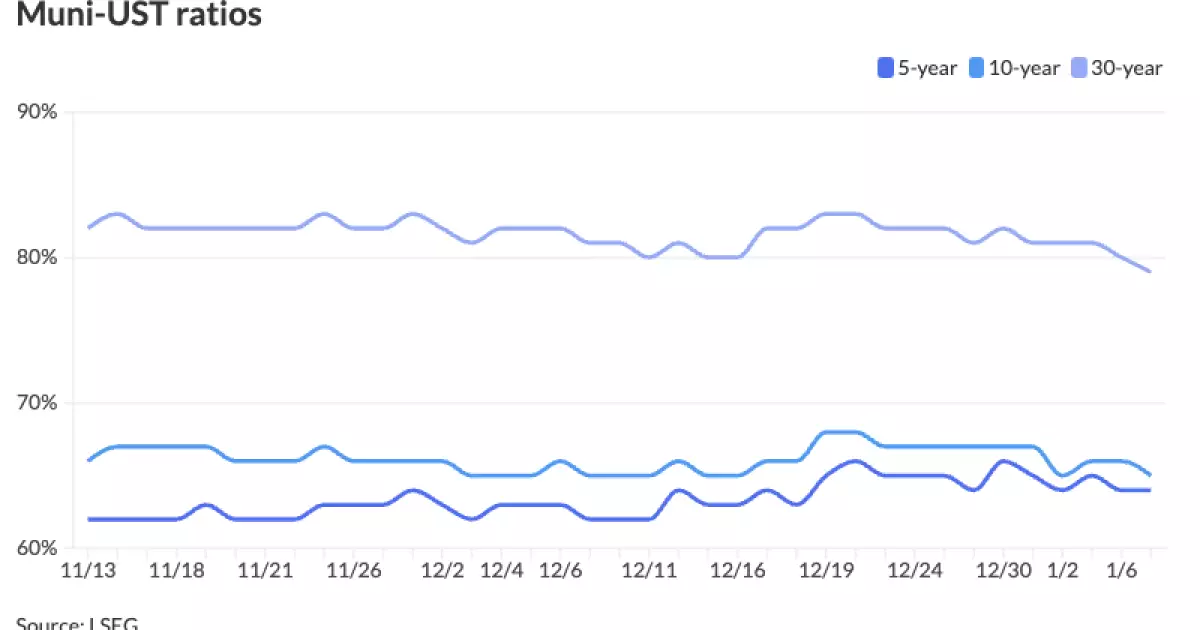The municipal bond market finds itself in a complex interplay of varying yield dynamics, particularly as it begins 2025. In contrast to an underwhelming performance observed in equity markets, municipal bonds have demonstrated a robust resilience, slightly overshadowing U.S. Treasury results while maintaining stability in yield curves. Recent reports indicate that the U.S. Treasury (UST) market has seen rates rise significantly, up to eight basis points for bonds maturing ten years and beyond. This shift has made municipal bonds more attractive, as their yields have remained relatively stable; for instance, two-year municipal-to-UST ratios have held steady at 64%, signaling a strong demand for tax-exempt bonds.
As the market prepares for a potentially historic new-issue calendar, influenced by concerns surrounding tax exemptions and the looming threat of new regulations by Republican lawmakers, sentiment seems cautiously optimistic. Matt Fabian of Municipal Market Analytics has noted that a “manageable” new-issue calendar combined with healthy demand from retail buyers may result in effective outcomes for underwriters—provided they tread lightly regarding yield adjustments.
Despite ongoing uncertainties, it appears municipal bonds are positioned for increased issuance in 2025. The last year showcased over $500 billion in municipal bond offerings, driven predominantly by consistent inflows into mutual fund vehicles. Analysts are eager to see whether the trends of 2024 will persist, especially with forecasts suggesting that first-quarter supply forecasts might eclipse previous expectations. A notable challenge remains; if yields do not maintain a sufficiently high rate, or if external factors disrupt market stability, the demand for tax-exempt securities could diminish, impacting overall performance.
Adding another layer is the observed volatility in net asset value (NAV) and subsequent outflows from mutual funds in December, creating a mixed bag of urgency and hesitance among investors. The retail side of municipal trading, already strained this year, could further feel the impact of external market fluctuations, especially if alternative investment vehicles become more appealing to buyers.
The performance trends suggested by various analysts, including the prospect of banks and insurance companies reducing their municipal holdings, raise questions about market stability and the sustainability of current pricing levels. This change ostensibly concentrates municipal bond investments in the hands of retail investors, underscoring the growing importance of this demographic in driving market sentiment.
In light of impending tax code changes—likely to arise due to legislative priorities surrounding immigration and tariffs—issuers are motivated to enter the market early in 2025, seeking to effectively sidestep any ancillary turbulence that could arise from legislative developments. Notably, both market observers and strategists are closely monitoring supply levels, which are anticipated to intensify in direct response to changes in tax legislation affecting key sectors such as higher education or private activity projects, reminiscent of trends observed in 2017.
As January progresses, significant issuances in the primary market are already underway. Recent pricing activities highlight notable transactions, such as Goldman Sachs structuring approximately $980 million in energy supply revenue bonds and Siebert Williams Shank facilitating $181 million for San Antonio’s water system refunding bonds. Stakes continue to rise as competitive offerings emerge, including educational initiatives and widespread infrastructure projects aligning with municipal financing demands.
Upcoming deals from districts and authorities across states showcase the resilience and adaptability of municipalities in leveraging bond markets to fund various initiatives. With the anticipated influx of new bonds, market participants are poised for continued engagement, balancing risk against potential rewards in a climate of shifting legislative and economic landscapes.
The municipal bond market is at a crossroads, characterized by a mixture of cautiously optimistic projections and external challenges. The momentum gained in previous years sets the stage for a potentially fruitful 2025, assuming that issuers strategically navigate the pressing uncertainties while maintaining attractive yield levels to draw in investors. As participants in this market adapt to evolving conditions, including tax policy changes and investor sentiment fluctuations, 2025 could unveil a subtler landscape of investment opportunities tempered with broader economic realities. The balance between preserving demand and accommodating supply will ultimately dictate the municipal bond market’s trajectory in the coming months.


Leave a Reply